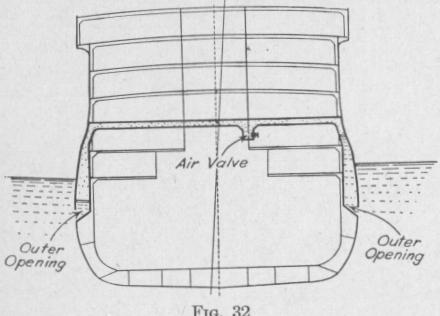42 PRINCIPLES OF ELEMENTARY DYNAMICS
surge back and forth through the constricted passages connecting the two tanks.
For the maximum rate of damping, the periods of the pendulous system and of the oscillating liquid should be equal, and the angular velocity of the pendulum and the torque acting on the pendulum due to the oscillating liquid should differ in phase by one-half period (Art. 25). These factors can be controlled within certain limits by the valve V.
This method has been used for damping the roll of ships (Art. 28), and is used for damping the vibration of certain gyro-compasses (Art. 137).
28. The Frahm Anti-Roll Tanks. - The rolling of a ship by periodic waves can be diminished through resonance by an oscillating mass of water surging back and forth from a tank on one side of the ship to a tank on the other side. The frequencies of sea waves vary from about five to eight per minute in deep water, and from about eight to eleven in shallow water. The period at any particular place does not remain constant for many minutes in succession. The phase of the wave motion changes whenever a wave crest topples over.
The Frahm anti-rolling device* consists of closed tanks placed opposite to one another at the two sides of the ship. The tanks are about half filled with water. In the earlier equipments designed by Frahm, the tanks were placed inside the ship, the lower parts of opposite tanks were joined by a water passage and the upper parts joined by an air passage controlled by a valve. In later equipments, the tanks have been placed on the exterior of the hull like the " blisters " commonly used on warships as a protection against torpedoes. The Hamburg-America line steamers Albert Ballin, Deutschland, Hamburg and New York are provided with such blisters extending above and below the water line along about two-thirds the length of the hull. The blister on each side is divided into three parts by vertical partitions. The upper parts of opposite tanks are joined by air pipes provided with adjustable valves. The lower parts of opposite tanks are not joined by water pipes but open into the sea, Fig. 32. The period of the water surging back and forth from one side to the other can be adjusted within certain limits by adjusting the air valves.
When the period of the waves is about the same as that of the
* U. S. Patent. Frahm, No. 970368, 1910; Frahm, No. 1007348, 1911.
SIMPLE HARMONIC MOTION 43
ship, the amplitude of roll of the ship will grow larger and larger through resonance. It is the purpose of the tanks to prevent such a building up of the roll amplitude. Suppose that the period of oscillation of the water back and forth from one tank to the other is about the same as the period of roll of the ship and that the velocity of the water surging back and forth from one tank to the other is one-half period behind the torque acting on the ship due
to the waves. Under these conditions the surging water will absorb energy from the rolling ship at the maximum rate (Art. 25). The required adjustment of period of surge of the water in the tanks and of the phase difference between the angular velocity of the ship and the torque acting on the ship, can be made by a man operating the valve in the pipe connecting the tanks. The maintenance of the proper adjustment is rendered very difficult by the two facts that the phase of the torque acting on the ship is changed when an oncoming wave topples over, and that the period of the waves is constant for but short spaces of time.
It has been proposed to use a gyroscope to operate this valve automatically.
The weight of the Frahm anti-rolling tanks and contents is from about three to five per cent of the weight of the ship, depending upon the constants of the ship. t
* Hammond, No. 1700406, 1929.
j Robb, Studies in Naval Architecture, pp. 289-304.
